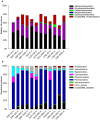Vertical profiles of bacteria in the tropical and subarctic oceans revealed by pyrosequencing
- PMID: 24236132
- PMCID: PMC3827353
- DOI: 10.1371/journal.pone.0079423
Vertical profiles of bacteria in the tropical and subarctic oceans revealed by pyrosequencing
Abstract
Community composition of Bacteria in the surface and deep water layers were examined at three oceanic sites in the Pacific Ocean separated by great distance, i.e., the South China Sea (SCS) in the western tropical Pacific, the Costa Rica Dome (CRD) in the eastern tropical Pacific and the western subarctic North Pacific (SNP), using high throughput DNA pyrosequencing of the 16S rRNA gene. Bioinformatic analysis rendered a total of 143600 high quality sequences with an average 11967 sequences per sample and mean read length of 449 bp. Phylogenetic analysis showed that Proteobacteria dominated in all shallow and deep waters, with Alphaproteobacteria and Gammaproteobacteria the two most abundant components, and SAR11 the most abundant group at family level in all regions. Cyanobacteria occurred mainly in the surface euphotic layer, and the majority of them in the tropical waters belonged to the GpIIa family including Prochlorococcus and Synechococcus, whilst those associated with Cryptophytes and diatoms were common in the subarctic waters. In general, species richness (Chao1) and diversity (Shannon index H') were higher for the bacterial communities in the intermediate water layers than for those in surface and deep waters. Both NMDS plot and UPGMA clustering demonstrated that bacterial community composition in the deep waters (500 m ~2000 m) of the three oceanic regions shared a high similarity and were distinct from those in the upper waters (5 m ~100 m). Our study indicates that bacterial community composition in the DOC-poor deep water in both tropical and subarctic regions were rather stable, contrasting to those in the surface water layers, which could be strongly affected by the fluctuations of environmental factors.
Conflict of interest statement
Figures





Similar articles
-
Vertical distribution and phylogenetic composition of bacteria in the Eastern Tropical North Pacific Ocean.Microbiol Res. 2009;164(6):624-33. doi: 10.1016/j.micres.2008.01.001. Epub 2008 Apr 2. Microbiol Res. 2009. PMID: 18387795
-
Bacterial diversity in the oxygen minimum zone of the eastern tropical South Pacific.Environ Microbiol. 2008 May;10(5):1244-59. doi: 10.1111/j.1462-2920.2007.01539.x. Epub 2008 Feb 18. Environ Microbiol. 2008. PMID: 18294206
-
Hydroids (Cnidaria, Hydrozoa) from Mauritanian Coral Mounds.Zootaxa. 2020 Nov 16;4878(3):zootaxa.4878.3.2. doi: 10.11646/zootaxa.4878.3.2. Zootaxa. 2020. PMID: 33311142
-
Contrasting Community Assembly Mechanisms Underlie Similar Biogeographic Patterns of Surface Microbiota in the Tropical North Pacific Ocean.Microbiol Spectr. 2022 Feb 23;10(1):e0079821. doi: 10.1128/spectrum.00798-21. Epub 2022 Jan 12. Microbiol Spectr. 2022. PMID: 35019678 Free PMC article.
-
Microbial community genomics in eastern Mediterranean Sea surface waters.ISME J. 2010 Jan;4(1):78-87. doi: 10.1038/ismej.2009.92. Epub 2009 Aug 20. ISME J. 2010. PMID: 19693100
Cited by
-
Prokaryotic assemblages and metagenomes in pelagic zones of the South China Sea.BMC Genomics. 2015 Mar 20;16(1):219. doi: 10.1186/s12864-015-1434-3. BMC Genomics. 2015. PMID: 25879764 Free PMC article.
-
Bacterial Community Profiling of Tropical Freshwaters in Bangladesh.Front Public Health. 2019 May 31;7:115. doi: 10.3389/fpubh.2019.00115. eCollection 2019. Front Public Health. 2019. PMID: 31214556 Free PMC article.
-
PhyloPlus: a Universal Tool for Phylogenetic Interrogation of Metagenomic Communities.mBio. 2023 Feb 28;14(1):e0345522. doi: 10.1128/mbio.03455-22. Epub 2023 Jan 16. mBio. 2023. PMID: 36645293 Free PMC article.
-
Identification of bacterial community composition in freshwater aquaculture system farming of Litopenaeus vannamei reveals distinct temperature-driven patterns.Int J Mol Sci. 2014 Aug 7;15(8):13663-80. doi: 10.3390/ijms150813663. Int J Mol Sci. 2014. PMID: 25105725 Free PMC article.
-
Gradients of bacteria in the oceanic water column reveal finely-resolved vertical distributions.PLoS One. 2024 Apr 2;19(4):e0298139. doi: 10.1371/journal.pone.0298139. eCollection 2024. PLoS One. 2024. PMID: 38564528 Free PMC article.
References
-
- Cole JJ, Findlay S, Pace ML (1988) Bacterial production in fresh and saltwater ecosystems: a cross-system overview. Mar Ecol Prog Ser 43: 1–10.
-
- Fuhrman JA, Sleeter TD, Carlson CA, Proctor LM (1989) Dominance of bacterial biomass in the Sargasso Sea and its ecological implications. Mar Ecol Prog Ser 57: 207–217.
-
- Aristegui J, Gasol JM, Duarte CM, Herndl GJ (2009) Microbial oceanography of the dark ocean's pelagic realm. Limnol Oceanogr 54: 1501–1529.
-
- DeLong EF, Preston CM, Mincer T, Rich V, Hallam SJ, et al. (2006) Community genomics among stratified microbial assemblages in the ocean's interior. Science 311: 496–503. - PubMed
-
- Gallagher JM, Carton MW, Eardly DF, Patching JW (2004) Spatio-temporal variability and diversity of water column prokaryotic communities in the eastern North Atlantic. FEMS Microbiol Ecol 47: 249–262. - PubMed
Publication types
MeSH terms
Substances
LinkOut - more resources
Full Text Sources
Other Literature Sources

